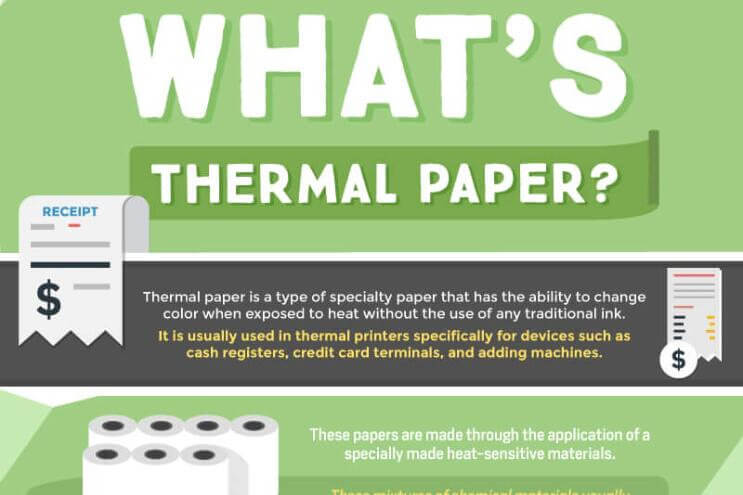Thermal paper is a type of specialty paper that can change color when exposed to heat, without the use of traditional ink. It is usually used in thermal printers specifically for devices such as cash registers, credit card terminals, and adding machines. Thermal paper is manufactured by the application of special heat-sensitive chemical materials to a paper base. The chemicals used can vary with the manufacturer.

1. What’s the Difference Between Thermal Paper and Regular Paper?
Thermal Paper
Thermal paper is different from regular paper because it’s coated with a mixture of dye and chemicals. When heated above the melting point, the dye reacts to the chemicals, causing a shift to a colored form (typically black but occasionally blue or red). The print head in the machine is able to heat the correct areas of the paper, making it legible.
Thermal paper contains three layers, although you wouldn’t notice by looking at it.

- The substrate layer is basically just the paper.
- The base layer acts as a binding element made from starches, gelatin, and alkali salts. This layer allows the heat to move through the paper.
- The active layer contains the chemicals that make the paper react to heat.
- An additional protective layer helps prevent the paper from fading. Not all thermal papers contain this layer.
How to Identify Thermal Paper?
There is a noticeable difference in the feel of the paper. Thermal paper has a somewhat slick surface and can be difficult to write on with a pen, whereas regular paper feels like ordinary copier paper. Usually, a scratch with a fingernail can produce a black mark on the surface of thermal paper.
2. Can You Use Thermal Paper in a Normal Printer?
Using thermal paper in a regular printer is not advisable. Thermal paper is designed to work in thermal printers, which use heat instead of ink. It is also thinner and more slippery. Thus, a regular printer would probably not produce good results. The same applies to using regular paper in a thermal printer.
3. How to Measure Thermal Paper Roll Size?
Knowing the correct paper roll size is the first step in selecting and using it in your printer. If you know the model of the receipt printer, you can Google the receipt printer model, you can usually get exactly what products (paper rolls, printer ribbons, cleaning supplies, etc.) are compatible.
If that isn’t available, the paper roll size can be obtained using these four measurements:
- Width – Use a ruler, measure across the face of the roll from side to side
- Diameter – from edge to edge of the thermal roll going directly through the center spindle hole in the roll
- Length – the length or amount of paper wound on the roll
- Core size – the diameter of the tube on which the thermal paper is rolled.
4. How to Buy Good Quality Thermal Paper Rolls?
-
Choose the right paper roll size
Thermal paper rolls come in many different sizes, to fit different printers and to meet different needs. Choosing the right paper size prevents wasting time with running out of paper, returning your paper roll order, etc.
-
Order the correct quantity
Be sure you order enough paper rolls to meet your needs. This way you have the best chance of getting discounts on bulk purchases, which are much more economical than frequent small orders.
-
Consider your budget and compare prices
Make sure that the paper rolls you buy are competitively priced. You can do this by considering your budget and comparing prices from different manufacturers for paper rolls of equal quality. Look for the best price, of course, but don’t make the mistake of trying to save a little money by buying low-quality products that will disappoint your customers. This will cost you more money in the long run.
5. Is Thermal Paper Toxic? How Do You Prevent Health Risks?

Bisphenol A (BPA) is an organic synthetic compound that is found in many plastic containers such as plastic bottles, cans, and stretch wraps. As a color developer, it is also often part of the coating of thermal paper and barcode labels.
BPA has been of concern due to its hormone-like properties as an endocrine disruptor. It is suspected of having negative health effects and being connected to risks of cancer, diabetes, obesity, and developmental disorders. Fortunately, BPA-free thermal paper is available. Buying BPA-free paper will eliminate this risk to you and your customers and protect you from possible liability.






